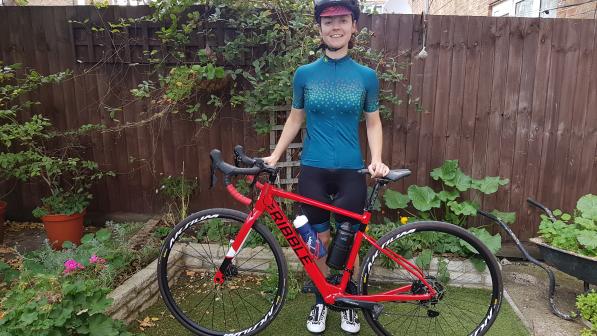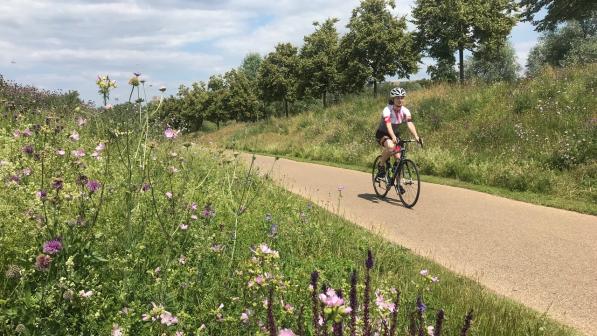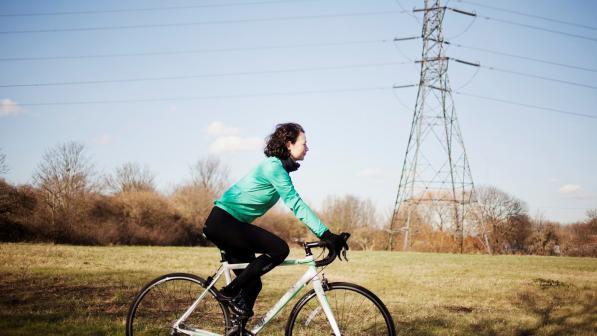How do you prepare for cycling from Land's End to John o' Groats?

How do you start to prepare to cycle 110 miles a day for nine consecutive days? This is the question I’m continually asking myself as the day I find out edges ever closer. To be honest, with eight weeks to go, I’m not sure I’ve found the answer yet.
I’ve been training for the Deloitte Ride Across Britain, which covers 980 miles of country between Land’s End and John o’ Groats, or LEJOG, in just nine days. While many of us may have trained for a day ride or two in our time, it is obviously something else entirely getting up day in, day out, to ride 110-odd miles, for nine days.
With around 18 weeks to train, I looked at British Cycling’s training plans, and worked out I could fit in their off-season training plan, followed by their in-season plan. Each week the plan essentially contained two short, intense cycling sessions, with one longer weekend ride, of varying duration. I downloaded the first 12-week programme and scheduled those rides into my diary. The weekend rides started off at two-odd hours, and built up, before undulating between two and five hours, with occasional ‘rest weeks’, where the duration and intensity are dialled down to allow your body to rest.
While it wasn’t a programme specifically for cycling 100 miles day in day out, it would build up my body to the task ahead.
I’d honestly become a little lazy over the winter, riding an e-bike for my commute, and little else. Luckily, in February, before I signed up to LEJOG, I vowed to largely switch back to the road bike. In March I took on the Hilly 50k sportive, in the Surrey Hills. My lack of fitness showed, but I finished it. In April I cycled the Caledonia Way for fun, on an e-mountain bike, with the electric assist on low.
The training kicked off for me the following weekend, with the Etape Loch Ness, a 66 mile sportive around the eponymous Loch. I was beginning to feel stronger by this point, and enjoyed the ride, but was very tired afterwards.
While some people taking on Land’s End to John o’ Groats will have years of long-distance cycling under their belt, and months of training in the run up, others will have taken up cycling just that year – so the variety in fitness levels taking on the challenge is pretty broad.
A lot of people say with most long, multi-day rides, you get fit as you go along, to an extent; the training just makes it easier to manage the hills. That, I’m told, is the case particularly on day two, across Devon - the hilliest day, of unrelenting undulating roads.
Having foolhardily cycled across Dartmoor last spring on a squeaky commuter bike fully laden with panniers, I remembered its topography well, and thus Devon remained my motivation for training – if not the carrot, then the stick.
For the first few weekends I picked out rides as I went along, that seemed to fit the prescribed number of hours on the training plan.
In the first few weekends I variously joined an Evans Cycles sportive, rode almost to Cambridge from my home in East London to see friends, joined an all-women’s club ride, took part in the annual London to Brighton ride, went mountain biking and made up various little routes in and around my local area, depending on how many hours the training plan recommended.
As for the shorter weekday rides, these required quite targeted, and often intense efforts of an hour to two hours, which are best done on a static bike where the efforts are easier to control. These sessions came with descriptions like under/over, spin out and 2x20 minute sweet spot, but I figured if I was doing some form of high intensity effort on a bike that would probably be fine.
High intensity interval training, or HIIT, is intense bursts of exercise with recovery periods between. It’s great for endurance events, as evidence shows it can bring about some of the same physiological adaptations as endurance training, only in less time.
I managed to get hold of a heart rate monitor, and even did an FTP (Functional Threshold Power) test on a static bike I was testing out. But I’ll be honest: I was often struggling with tiredness after the weekend rides, and the weekday rides were not as frequent as they could have been. Things got better when I splashed out on membership of my favourite spin classes, though.
The point of training, of course, is to get your mind and body used to a certain amount of effort, to make that effort easier, and work out your own fuelling strategy.
If things go wrong in your training that’s good because it means they won’t go wrong during the event.
Emily Chappell
I’d met up with ultra-cyclist Emily Chappell shortly after signing up for LEJOG, and she gave me some advice about managing my body and brain under the strain of riding 100 miles a day. She told me if things go wrong in your training that’s good because it means they won’t go wrong during the event.
Riding 110 miles a day, for nine days, means, as Emily put it, your body becomes a furnace, and as you can only absorb so many calories per hour, it’s important to stay on top of the fuelling. She also suggested it can help to treat oneself as if you were looking after another person, or a child – asking basic questions like, am I hungry, am I tired, am I thirsty?
On one sportive I rode, there was no feed stop for the first 35 miles and, weirdly, I hadn’t brought any food with me beyond a banana I’d already eaten on the train. By 20 miles, I’d started to flag in a bad way, and was saved by fellow riders offering me their food.
As the miles ramped up each weekend, I found myself constantly tired. I realised after a couple of weeks I hadn’t been eating enough, and upped the calories. I soon became heavier than I’d been for years, albeit by 1kg or two, but at least I was less tired.
I was also lucky enough to have support in the form of the Boardman Performance Centre.
Being on the bike eight hours a day is a big ask of any body, and I wanted my bike setup to be right. Their physio and bike fit wizard, Bianca, took a mould of my foot, set me up with supportive in-soles, and told me I needed bigger shoes. She advised I get 4cm narrower handlebars, moved my saddle and advised on ways to improve my pedal technique. Those apparently small tweaks resulted in what seemed to be a 10% improvement in power output – results which showed on the stats from my next spin class. The bike was certainly more comfortable afterwards.
I also invested in intermittent massages to avoid injury, and weekly Pilates classes, in the hopes of improving core strength, stretching, and reducing the risk of injury. In a similar vein, GCN’s YouTube video has a number of instructional videos on warming up, cooling down and stretching.
I definitely haven’t nailed the training, but I’m trying my best. Time will tell if it’s enough.






